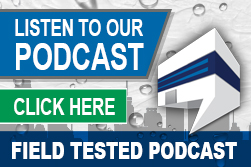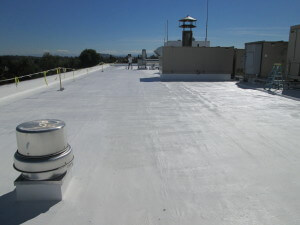Silicone Roof Coatings
Silicone is commonly applied at 2 gallons per SQ as a roof maintenance application. This is not a full-system according to the manufacturers of silicone roof coatings. A thin layer of coating applied like this does not come with a manufacturer’s warranty. Unfortunately, silicones are sold to property owners as if they do come with a warranty, often thought to be as long as 50 years. It’s not true!
|
Figure 1
|
Figure 2
|
Figure 3
|
Unfortunately it is often too late by the time the property owner discovers this. Once the roof has a silicone coating applied to it, regardless of the roof type (metal, BUR, SPF, etc.) there is no other product that will adhere to it. In many cases not even another application of silicone will adhere to a silicone roof! Silicone roofs are a one-way street… The only way to repair a silicone roof is to tear it off.
The strength for both SureCoat and silicone are similar at 2 gallons per SQ (100 SF) with a psi tensile strength of 480 to 490 psi. 2 gals per square is only a “cool roof conversion” with both SureCoat and silicone. To obtain a warranty for either system, the systems must be installed per manufacturer’s specification. Roof specifications differ depending on the roof type applied to. With other manufacturer’s this requires separate products such as basecoats, primers, mastics and an entirely different product for the reflective topcoat, often incapable like “oil & water”.
But don’t just take our word for it, look for yourself! You can access CRRC results showing initial and aged testing results (unless the product is new; the results will show pending). If the aged results drop by 15% or more, the product is not UV stable.
If you look at different manufacturers of silicone products on the CRRC test results are 25-45 points less than originally reported. The SureCoat Roof System coatings only drop by 5 to 11 points in the same period of time (3 years). SureCoat and can be cleaned with SureSkrub to regain lost reflective points because in the case of the SureCoat Roof System, the lowered reflectance is due to dirt.
This is not true of silicone roofs. Silicone does not hold up to UV and heat. The overall loss in Solar Reflective Index (SRI) for silicone and acrylic coatings as well as traditional single-ply roofing membranes is from UV degradation in addition to ordinary dirt. The dirt, degraded rubber and plastics are nearly impossible to remove without harsh cleaners on these types of roofs because the dirt begins to embed itself in the material as it degrades. If you were to even power wash an acrylic roof, the acrylic roof paint would begin to come up, exposing the unlaying roofing materials which are unable to emit any UV causing damage.
All the numbers used in comparing data come from real manufacturer published literature available publicly online. UV Stability, Permeability and SRI all contribute to the Longevity and overall Sustainability of a Roof System. – See more at: http://surecoatsystems.com/silicone_roof_coatings.asp#sthash.uWUXwPwK.dpuf




